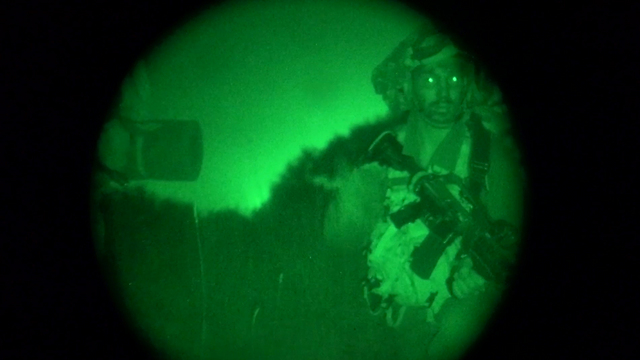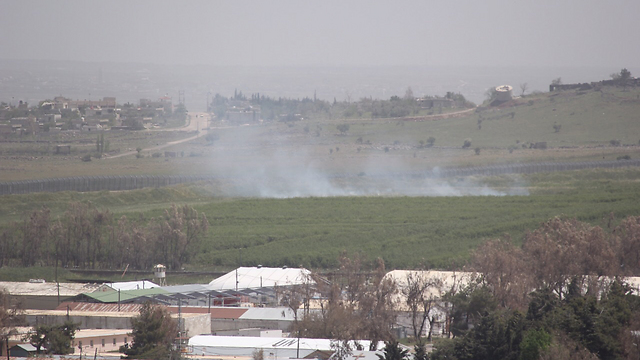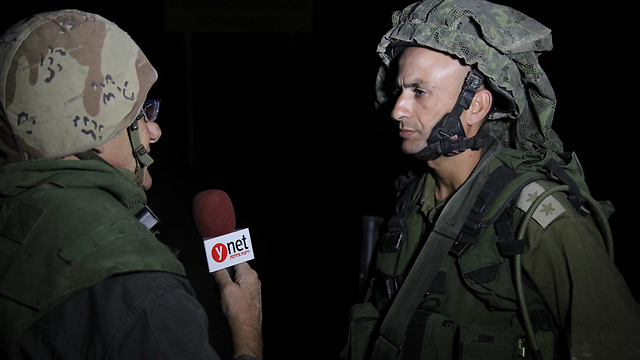Ron Ben-Yishai gets an exclusive inside look at Israel’s secretive intelligence collection efforts at the Syrian border, where IDF observations posts are only a few hundred meters away from armed rebels.
Inside a bush on a dark and hazy night in the Golan Heights, you truly begin to understand how much work goes into preventing the Middle Eastern chaos from spilling over into Israel.
The thick haze that blanketed Israel this last week hid not only the Syrian village a mere few hundred meters from us, but also the fighters surrounding it.
I couldn’t see a meter in front of me. I heard things, branches breaking, occasionally knocks on the metal below us, and I understood that the field intelligence soldiers were building their hidden observation post, which would become their home for the next day.

The team, which walked from position to position, and used the most advanced observation technologies, was truly the eyes of the IDF’s intelligence and prevention capabilities – a complicated branch tasked with spotting Syrian positions that threaten the Golan communities before they attack, while immediately marking them as targets for the operational troops and support fire: Aircraft, missiles, or artillery, which the IDF uses to prevent or deter attacks in the region.
The days of field intelligence troops counting tanks and missile batteries are long over. Today the main threat to Israel in the Golan is much more acute and a much less existential than the type of all-out warfare that was fought here in the Yom Kippur War.
In contrast to Assad regime’s dream of capturing the Golan, the Iranian players – Soleimani and Khamenei – dream of destroying Israel through a long and daunting war of attrition, a campaign consisting of unrelenting terror attacks and missile fire that will physically and psychologically exhaust Israel’s citizens, causing them to flee to Europe or America.
Alongside the Iranian threat we have that posed by radical Sunni Islam, which also aims to destroy Israel through a continuous campaign, but has postponed the campaign until they can claim victory over their Shi’ite rivals and secular Arab rulers.
The IDF is preparing for exactly these scenarios.

From the Israeli point of view, there are three types of people on the other side of the fence in the Golan: True enemy actors, potential enemy actors, and potential partners.
The true enemy actors are those who prescribe to radical Shia Islam, which is led by Iran: The Syrian Army, Hezbollah, Palestinian groups, Syrian militias – including every armed minority loyal to Assad.
The Iranians and Hezbollah declared the Golan the new active “resistance front” against Israel back in 2014, and have acted accordingly since. The IDF works towards quashing these actions through active defense and through military retaliations over attempted attacks.
The potential enemy actors are all the organizations and groups devoted to militant Sunni Islam, Salafist jihadism, or partake in the global jihad movement. Some of them are already present in the Syrian Golan, including the Nusra Front, which is a Syrian Al-Qaeda affiliate, and Shuhada Al Yarmouk, which acts on behalf of ISIS.
Most of the groups are local Salafist groups. The common denominator between all of the groups is the collective motive to attack Israel, but also a singular cost-benefit equation preventing them from acting on this.
They don’t want to add Israel to their already challenging battles against Assad, and they have a strong interest in the continuing humanitarian support Israel gives to the border villagers, mainly medical attention for the wounded.
The third category – the potential partners – includes the uninvolved residents of the Syrian Golan, the secular rebels, the FSA, local militias, and members of the Druze, Christian and Circassian communities.
I use the word partner and not “ally” because we are talking about ad hoc mutual interests, not partnerships evolving out of mutual values or shared traditions. These are desperate people who are under existential threats, and if we know how to get them on our side, they won’t forget it when we need them.
Israel’s national security interests force us to consider how to handle every one of these groups in a different manner.
The IDF’s mission in the Golan is to prevent terror attacks, and deter our enemies, but also to prevent war or delay it for as long as possible.
According to the accepted security strategy in the defense community, was thought up by Defense Minister Moshe Ya’alon, Chief of Staff Gadi Eisenkot and former chief of staff Benny Gantz, we must prevent being dragged into a war as a result of friction or an incident on the ground that spirals out of control, or because a resulting misunderstanding with the Iranians and their partners.
On the other hand, we must act to prevent terror or rocket and mortar fire, and we cannot allow attempts to attack us to go unanswered. Each attack should have a heavy price, which will deter any potential future attacks, but won’t cause an all-out war.
Preparing against ISIS
In order to walk this thin line, be efficient, and act proportionately at the right place and time, a very complex intelligence effort is required. The type of effort that will provide early warnings allowing prevention of attacks on the strategic and local levels, locate positions quickly, or give an educated guess as to the origins of the fire, who was behind it, and why.
All while providing commanders on all levels with a real-time picture of the forces on the Golan.
Ideally, not all the armed groups on the Golan, and not even all the Islamists, are enemies, but if ISIS arrives in the border region – even if they don’t act against us – the IDF will have to be aware, and prepare. In order to be prepared, and in order to be able to act quickly, the IDF must know the tiniest details about the groups in the border region.
The intelligence effort currently tasked with finding out all the details consists of many sources, revolving around the field intelligence units. These units once belonged to the Intelligence Corps, but today, due to their close ties with the IDF’s other field units, and the varied fire support units, they have been transferred to the ground forces division of the IDF, and have become their own independent corps.
This corps includes intelligence units who can spend days hiding in the field and report back to the decision-makers. Meanwhile, soldiers spend long hours looking at screens in intelligence collection war rooms, monitoring cameras that are in the field day and night, while others operate sensors in various places.
Last week, when dusty haze engulfed Israel, we accompanied a Combat Intelligence Collection infantry team in the Golan Heights. As far as I know, this was the first time the media – and hence the public – got the chance to see such a team’s operations up close.
“Our mission is to protect Israel and its citizens,” says battalion commander Lieutenant General Nir Megidish. “We therefore go out into the field and collect intelligence according to what has been designated important information by those in charge of that. We don’t just sit in the field and watch.”

In order to fulfill such a mission, the team we accompanied traveled to an observation post in the central Golan Heights, across from a Syrian village where Islamist rebels, including some allied to the Nusra Front, are present.
The goal is to study the village – which most uninvolved residents have fled – and discover who is still there and where, and to report any unusual activity.
Following a short briefing, we took a short trip to a preselected location to set up the observation post. Each soldier carried dozens of kilograms’ worth of sophisticated equipment, arms, food and water.
The thick darkness made the journey much more difficult, particularly when we reached the thicket where we were to hide. The Syrian village, and even the border fence, could not be seen despite being only a few hundred meters away.
There were only twinkles of a few yellow lights, nothing more. But when a soldier finished camouflaging the post and the observation device known as “Matan” was deployed and began operating, we saw the village and its armed inhabitants. The image looked “synthetic”, like what you see through night-vision goggles, but even from our distance, we could easily distinguish the village’s water tower and a Russian-made APC manned by two soldiers.
Nir, the battalion commander, explained that this was apparently an APC that the rebels captured from the Syrian military, now used to defend the village. No one has attacked the group in the village, but it looked like they expected it to happen.
We whispered goodbye to the soldiers, the lookout, and the team’s commander, who had all disappeared into the thicket, and return to where we started. After a few days in the heat and dust, they too returned, along with a trove of essential information, to celebrate Rosh Hashanah at home.
As reported by Ynetnews
